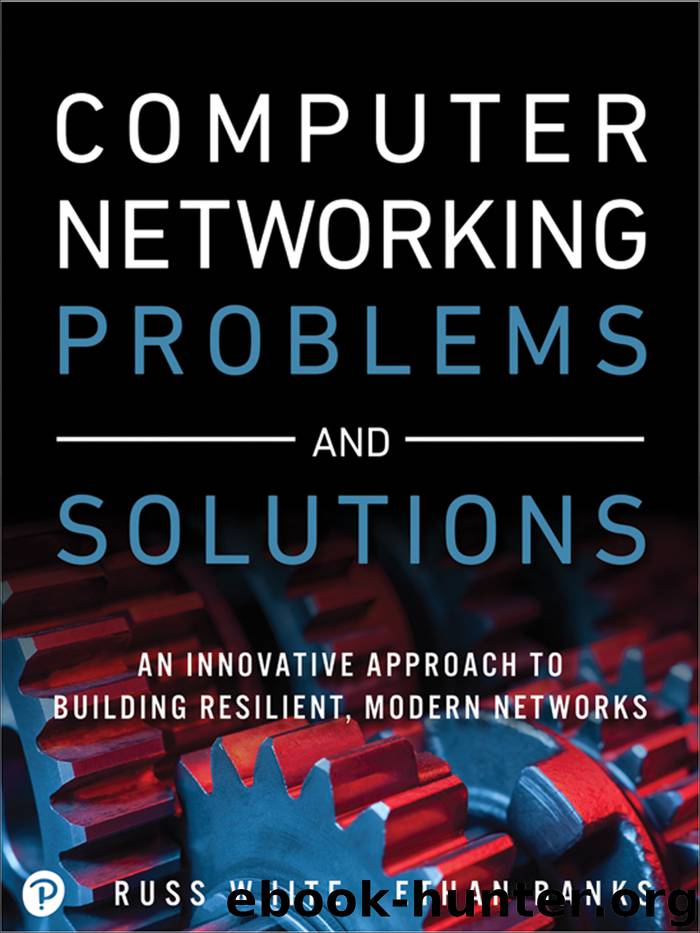Computer Networking Problems and Solutions by Russ White Ethan Banks & Ethan Banks

Author:Russ White,Ethan Banks & Ethan Banks
Language: eng
Format: epub
Publisher: Pearson Education Limited (US titles)
Published: 2018-06-15T00:00:00+00:00
The Routing Information Protocol
The Routing Information Protocol (RIP) was originally specified in RFC1058, Routing Information Protocol, published in 1998.2 The protocol was updated in a series of more recent RFCs, including RFC2435, RIP version 2,3 and RFC2080, RIP Next Generation for IPv6.4 Figure 15-7 is used to explain RIP operation.
Figure 15-7 RIP Operation Example
The operation of RIP is deceptively simple. In Figure 15-7:
1. A discovers 2001:db8:3e8:100::/64 because it is configured on a directly attached interface.
2. A adds this destination to its local routing table with a cost of 1.
3. As 100::/64 is installed in the local routing table, A will advertise this reachable destination (route) to B and C.
4. When B receives this route, it will add the cost of the inbound interface so that the path through A has a cost of 2, and examine its local table for any lower-cost routes to this destination. As B has no other path to 100::/64, it will install the route in its routing table and advertise the route to E.
5. When C receives this route, it will add the cost of the inbound interface so that the path through A has a cost of 2, and examine its local table for any lower-cost routes to this destination. As C has no other path to 100::/64, it will install the route in its routing table and advertise the route to D and E.
6. When D receives this route, it will add the cost of the inbound interface from C so that the path through C has a cost of 3, and examine its local table for any lower-cost routes to this destination. As D has no other path to 100::/64, it will install the route into its routing table and advertise the route to E.
7. E will now receive three copies of the same route; one through C with a cost of 3, one through B with a cost of 4, and one through D with a cost of 5. E will choose the path through C with a cost of 2, installing this path to 100::/64 into its local routing table.
8. E will not advertise any path to 100::/64 toward C, because it is using C as its best path to reach this specific destination. Thus, E will split horizon its advertisement of 100::/64 toward C.
9. While E will advertise its best path, through C, to both D and B, neither will choose the path through E, as they already have better paths available toward 100::/64.
RIP advertises a set of destinations and costs one hop at a time through the network; hence it is considered a distance vector protocol. The process that RIP uses to find a set of loop-free paths through the network is considered a distributed form of the Bellman-Ford algorithm, but it is not obvious how the process that RIP is using is related to Bellman-Ford.
Download
This site does not store any files on its server. We only index and link to content provided by other sites. Please contact the content providers to delete copyright contents if any and email us, we'll remove relevant links or contents immediately.
Sass and Compass in Action by Wynn Netherland Nathan Weizenbaum Chris Eppstein Brandon Mathis(7402)
Grails in Action by Glen Smith Peter Ledbrook(7295)
Kotlin in Action by Dmitry Jemerov(4638)
Management Strategies for the Cloud Revolution: How Cloud Computing Is Transforming Business and Why You Can't Afford to Be Left Behind by Charles Babcock(4131)
The Age of Surveillance Capitalism by Shoshana Zuboff(3422)
Learn Windows PowerShell in a Month of Lunches by Don Jones(3242)
Mastering Azure Security by Mustafa Toroman and Tom Janetscheck(3027)
Mastering Python for Networking and Security by José Manuel Ortega(2951)
Blockchain Basics by Daniel Drescher(2891)
TCP IP by Todd Lammle(2639)
Microsoft 365 Identity and Services Exam Guide MS-100 by Aaron Guilmette(2605)
From CIA to APT: An Introduction to Cyber Security by Edward G. Amoroso & Matthew E. Amoroso(2483)
Hands-On Azure for Developers by Kamil Mrzyglod(2411)
Configuring Windows Server Hybrid Advanced Services Exam Ref AZ-801 by Chris Gill(2361)
React Native - Building Mobile Apps with JavaScript by Novick Vladimir(2340)
MCSA Windows Server 2016 Study Guide: Exam 70-740 by William Panek(2313)
The Social Psychology of Inequality by Unknown(2310)
The Art Of Deception by Kevin Mitnick(2297)
Azure Containers Explained by Wesley Haakman & Richard Hooper(2251)
